Kentucky is on the southern side of the US, due to its lush woodlands, Kentucky is home to a number of wild animals like turtles, possums, rabbits, rodents, black bears, deer, and many more.
This state is rich in the number of turtle species native to it. So how many turtle species are there in Kentucky?
Kentucky is home to about 17 species of turtles, both marine and terrestrial. These species are listed below:
- Alligator Snapping
- Common Musk
- Common Snapping
- Eastern Box
- Common Map
- Eastern Mud
- Eastern Spiny Softshell
- Eastern River Cooter
- Hieroglyphic River Cooter
- False Map
- Midland Painted
- Mississippi Map
- Midland Smooth Softshell
- Ouachita Map Turtle
- Southern Painted Turtle
- Mississippi Mud
- Red-eared Slider
In this article, we will focus on the different characteristics of each of these species, their breeding habits, and their conservation status. By the end, we hope that you will understand more about the turtles in Kentucky, how to identify and take care of them.
1. Alligator Snapping Turtle
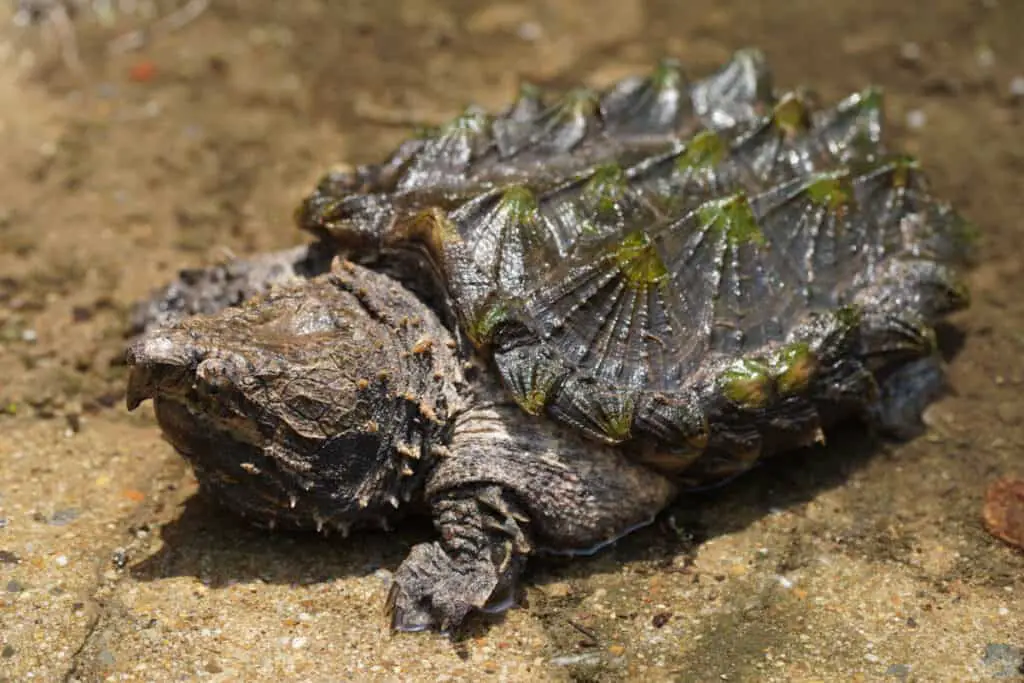
The scientific name for this turtle is Macroclemys temminckii. Alligator turtles get their name from the roughness of their upper shell, which is heavily spiked, resembling the skin of an alligator. They are either dark brown or black. Like other snapping turtles, they also possess a beak-like mouth.
Alligator snapping turtles are fairly big- reaching between 15 to 26 inches for mature turtles.
The lifespan of an alligator snapping turtle is between 60 and 70 years in the wild. These turtles are aquatic and are usually found at the bottom of rivers, lakes, ponds, swamps, sloughs, and bayous. They don’t actively hunt but lay at the bottom of the water bodies with their mouths open and wait for prey to swim inside.
Alligator snapping turtle species are omnivores and mostly feed on crustaceans, mollusks, algae, invertebrates, other small marine animals, and aquatic vegetation.
Breeding in alligator turtles occurs once a year. A female turtle will lay a clutch containing a minimum of 8 and a maximum of 52 eggs. The incubation process takes between 100 to 140 days. For this turtle, sexual maturity in both males and females is achieved between the 11th and 13th years. The whole process of reproduction happens between April and October.
In conservation terms, they are considered a vulnerable species. The main threat to their population is habitat destruction. In Kentucky, it is illegal to own an alligator snapping turtle.
2. Common Musk Turtle
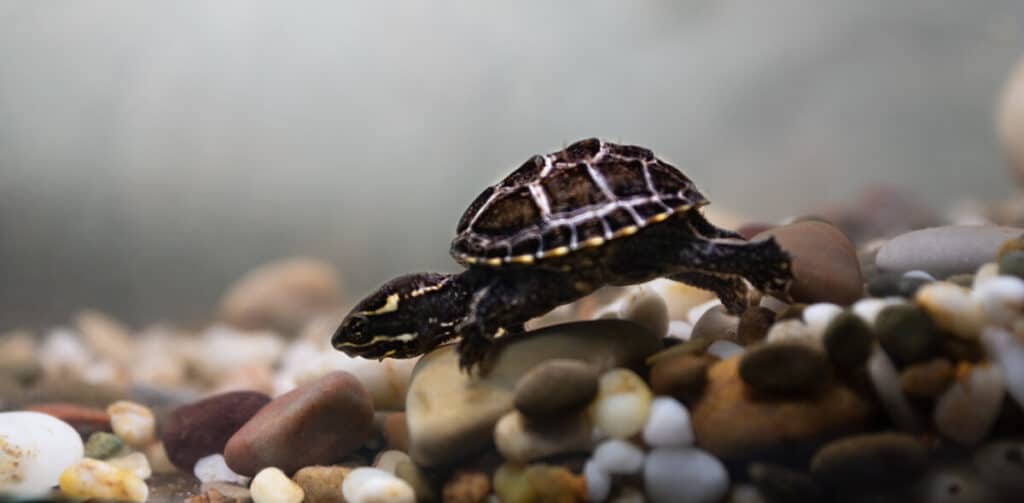
This turtle’s scientific name is Sternotherus odoratus. It is nicknamed “Stinkpot” owing to the strong odor it produces via the musk glands when threatened. A common musk turtle may also be, at times, called the eastern musk turtle.
They are usually small turtle species measuring between 2 and 4.5 inches.
A common musk turtle has a black or brown carapace that is slightly domed and broadens towards the front part. The skin resembles the carapace but with a lighter shade. This musk turtle has a brown or yellow carapace and two unique lines behind the eyes running to the neck.
Common musk turtles are common in slow-moving water bodies, rivers, ponds, sloughs, and swamps. Since they spend most of their time basking in the sun, they prefer mostly areas with rocks. They will also take shelter in dead logs and hollow trunks. Being omnivores, common musk turtles’ diet comprises crustaceans, mollusks, algae, marine vegetation, and other small marine animals.
Musk Turtles reproduce between the months of May and September. They lay between 4 and 9 eggs in a clutch and may lay up to two clutches in a year. Incubation takes between 75 and 95 days to hatch. Maturity in females takes four years while males take three years.
Common musk turtles are an endangered species in Kentucky, and the commercial business of these turtles is highly controlled.
3. Common Snapping Turtle
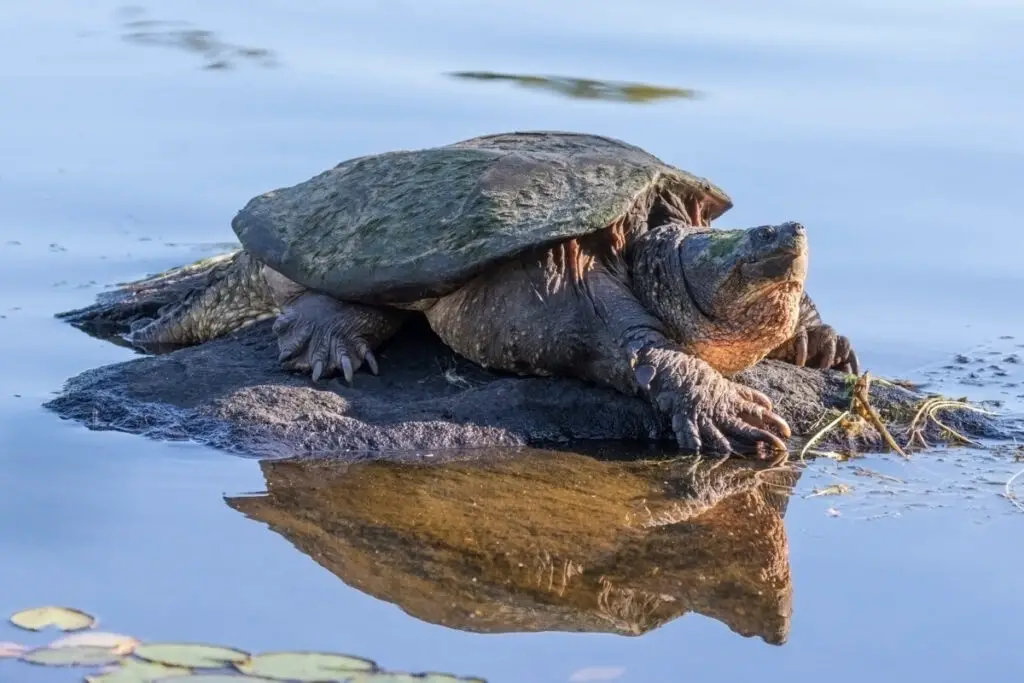
Scientifically, these turtles are called Chelydra serpentina. These turtles have a rugged look with rough shells. Their carapace is ridged, but the ridge becomes less pronounced with age. One of the most distinctive characteristics of these turtles is a long tail that is almost the size of their bodies. The carapace is sometimes brown or tan. Their skins are also quite rough.
Common snapping turtles average between 12 and 15 inches when mature.
Being aquatic, they inhabit slow-moving water bodies like rivers, lakes, ponds, swamps, and ravines with muddy bottoms. They are also known to be cold tolerant and are able to survive in very cold waters and frozen lakes.
Like most turtles, common snapping turtles are omnivores, and their diet mainly comprises snails, insects, invertebrates, algae, marine vegetation, and other aquatic insects. They will either scavenge or actively hunt their prey.
Breeding in snapping turtles occurs between May and September. The females will lay eggs by July, and incubation then proceeds for about 100 days. A clutch contains between 20 and 40 eggs. Sexual maturity in females takes about 15 years.
For pet owners, a snapping turtle is quite aggressive, and their strong jaws and mouth can cause serious damage if not handled well. You will need great skills to take care of these turtles and hence are not suitable for beginners.
4. Eastern Box Turtle
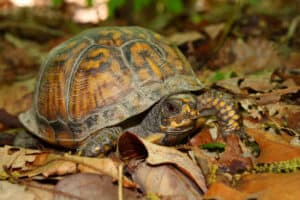
The biological term for this turtle species is Terrapene carolina carolina. In terms of appearance, their shells range from brown to black and are dome-shaped. One of the most recognizable features of these turtles is the blob patterns on the carapace. While the carapaces may vary in color, they are mostly red, orange, or yellow. Its skin has the same patterns as the shells but with brighter yellow or orange spots.
Eastern box turtles are moderately sized turtles measuring between 5 and 7 inches.
These turtles are terrestrial and spend most of their lives on open grasslands, woodlands, and meadows. Being omnivores, box turtles have a wide range of diets, including insects, fruits, birds, seeds, caterpillars, vegetation, and vegetables.
Their nesting period lasts between May and late August. Incubation takes about 80 days. About 2 to 8 eggs are laid in a single clutch, and only one clutch is laid each year. This species achieves sexual maturity between 10 and 20 years with a lifespan of 100 years.
Eastern box turtles are considered endangered as they are a favorite pet turtle. Due to the increased commercial activities of these turtles, the state of Kentucky has regulations on keeping pet box turtles. This is in a bid to conserve their numbers.
5. Common Map Turtle
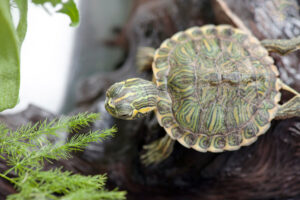
Biologically, this map turtle’s species is referred to as Graptemys geographica. Their name originates from the map-like patterns on their carapace. This turtle is one of the most common pond turtles in the US. They also inhabit large lakes, rivers, small rocky streams.
Females may achieve a carapace length of up to 10.5 inches, while males are smaller, reaching only 6.2 inches. Its carapace assumes a green or olive green color with intricate map-like patterns hence the name map turtle. Similarly, the skin has an olive green color but many yellow stripes on both the upper and lower sides. The plastron is yellow or orange with thin dark lines.
As with most turtles, map turtles are omnivores, but their diet leans towards meat than plants. They mainly feed on freshwater mollusks and mussels, aquatic insects, crayfish, and vegetation.
Common map turtles have a lifespan of about 40 to 50 years.
Male and female turtles take different times to attain sexual maturity. A male turtle will take an average of 5 years, while a female takes about ten years.
Breeding starts in May and ends in September; eggs are laid by the end of July. Incubation starts soon afterward and lasts for about 75 days. On average, a clutch has between 10 and 12 eggs. A female map turtle will lay between 2 and 3 clutches each year.
While they are not considered as threatened, common map turtle numbers have declined in Kentucky. This has majorly resulted from the destruction of freshwater bodies, which in turn has led to a decline in freshwater mollusks population which is a major source of food for these turtles. For pet owners, not many skills are needed here; hence the turtle is suitable for beginners.
6. Eastern Mud Turtle
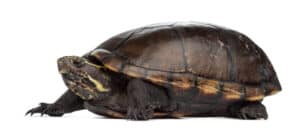
Their biological name is Kinosternon subrubrum subrubrum. Eastern mud turtles are small, brown, or olive turtles with a smooth and unmarked carapace. The plastron is double hinged and is either brown or yellow. Their skin has a lighter olive green color as compared to their shells.
They are pretty small, averaging only 3 to 5 inches in carapace length.
Eastern mud turtles are semi-aquatic, which means that they spend their lives on both land and water. They, however, prefer land to water. On the water, they are found in slow-moving and shallow water bodies like ponds, marshes, and streams. On land, they are common in areas with plants and lots of dead vegetation.
These turtles are slow swimming and prefer to crawl at the bottom.
In terms of food, eastern mud turtles are omnivores with a diet mainly consisting of mollusks, crustaceans, insects, algae, seeds, and other vegetation. These turtles either scavenge or lay in wait to ambush their prey. During winter, they hibernate on land under dead vegetation.
Reproduction in eastern turtles starts in late June to September. Females lay eggs by the end of July, and then incubation starts and lasts till late August or early September. A mud turtle will lay between 2 and 5 eggs in each clutch. Only one clutch is laid each year. Sexual maturity in mud turtles in females is achieved by the 8th, while in males, it is after the 6th year.
These turtles have a lifespan of 40 to 50 years.
One of the greatest sources of mortality for these turtles is the draining of wetlands for development. For pet lovers to take care of this turtle, you will need previous turtle experience as a mud turtle can be quite demanding.
7. Eastern Spiny Softshell
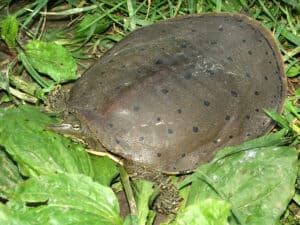
Biologically, Eastern Spiny softshell is known as Apalone spinifera spinifera.
Spiny softshell turtles have broad rubbery and flattened shells but with a slight ridge. The carapace is usually brown or olive with dark spots. Its skin has a lighter yellow, brown, or olive color as compared to the carapace. A mature female is almost twice as large as a male, measuring between 7 to 19 inches, while a male measures 5 to 10 inches.
The turtle has a distinctly long and pig-like nose with a small head. The feet are also webbed, and this is an indication that the turtle is a great swimmer. Spiny softshell turtles are common in slow-flowing water bodies like streams, ponds, swamps, and lakes with soft bottoms and little vegetation.
When it comes to diet, spiny turtles are carnivores eating almost all small animals from insects, crustaceans, fishes, crayfish, and other marine animals. Their hunting technique is burying their heads under the stand and ambushing their prey when they draw close.
Reproduction in Eastern spiny softshell happens in the months between April and October. By May, these turtles lay between 4 and 30 eggs on loose soils. Incubation in eastern spiny turtles takes between 80 and 100 days for the eggs to hatch. Sexual maturity in females is attained between the 8th and 10th years. Their lifespan is about 50 years.
Eastern spiny softshell turtles are not considered a threatened species.
8. Eastern River Cooter
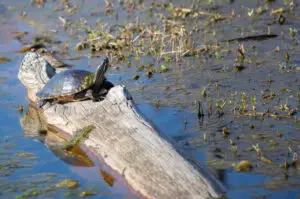
Their scientific or rather Latin name is Pseudemys concinna concinna. Eastern River Cooter turtle is a large aquatic turtle with adults attaining a carapace length of up to 16.5 inches. Its carapace is elongated and domed with serrated edges towards the rear. The carapace color ranges from green to greenish-brown to olive with yellowish or cream streaks. The plastron is yellow and is bordered by thin black lines.
The skin of this turtle species has a green, olive, or brown color with distinct yellow lines that run along the limbs, head neck. A distinctive difference between males and females is that males have longer tails and foreclaws, sometimes double the length of those in females.
Eastern River Cooter turtles are commonly found in large rivers, ponds, and lakes with slow-moving water. They prefer areas that have ample and open basking sites but with plenty of vegetation. Cooters are known to walk long distances over 700 meters in search of good basking sites.
Eastern Cooters are considered omnivores but lean heavily towards plants. Their diet includes green algae, eelgrass, aquatic vegetation, crayfish, tadpoles, worms, among other small marine animals. They get most of their food in water, as that is why they spend most of their lives.
Nesting in Eastern Cooters happens between May and June. A female cooter turtle will lay between 10 and 25 eggs in a clutch. She may lay a total of 3 clutches in a year. Incubation takes about 90-100 days, and hatchlings start emerging in late August and early September. Cooter turtles achieve sexual maturity from age six or a plastron length of 9 inches.
For pet turtle enthusiasts, an eastern Cooter turtle is easy to take care of, which means that they will require little skills. You need to, however, be careful when handling them as they can sometimes be aggressive.
9. Hieroglyphic River Cooter
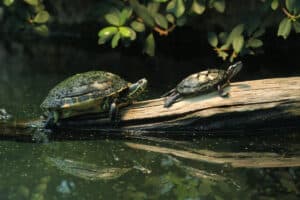
This turtle species is known by its scientific name, Pseudemys concinna hieroglyphica. They are a subspecies of the River cooter turtles. Hieroglyphic river cooter turtles are aquatic and will spend most of their lives in water. Like their cousins, the Eastern Cooters, they love basking in the sun.
At maturity, these turtles can attain a length of 12 inches.
The appearance of a Hieroglyphic turtle is very similar to that of the eastern cooters. Their brown carapace is slightly domed with intricate yellow or orange markings. The carapace has a slight vertebral keel which disappears as the turtle ages. The plastron is cream-colored and may sometimes have a shade of yellow.
Hieroglyphic turtles are omnivores feeding on algae, aquatic plants, grass, and vegetation. To supplement their proteins needs, they feed on invertebrates, crustaceans, and small fish. They are active turtles that hunt for food as they are also good swimmers.
Breeding in these turtles takes place between April and October. A female matures by the 8th year and lays between 10 and 30 eggs in one clutch. She may lay more than one clutch each year. Egg-laying lasts through the end of June. Incubation takes between 80 and 100 days, after which the hatchlings start emerging by late September.
10. False Map Turtle

The biological name for false map turtles is Graptemys pseudogeographica. They have some yellow lines on the carapace that form a map-like pattern hence the name. These are medium-sized, measuring between 3.5 and 10.5 inches. Females are bigger with a broader head than males.
The carapace may be olive, black, or brown with some yellow lines all around. Its skin resembles the carapace, but the lines vary from yellow to orange. False map turtles have a prominent keel that fades with age.
False map turtles are common in freshwater bodies inhabiting large rivers, lakes, bayous, marshes, and ponds. They prefer shallow, slow-flowing water bodies with plenty of vegetation. These turtles are mainly omnivores, and their diet includes mollusks, invertebrates, insects, small fish, and little amounts of vegetation and other plant life.
A false map turtle’s lifespan is about 35 years.
Reproduction in map turtles occurs twice a year, in April and again in October. It takes from four years to six for a male turtle to achieve sexual maturity, while the females take between eight and fourteen years. A female false map turtle lays a clutch containing 8-22 eggs. Incubation takes between 80 and 90 days.
11. Midland Painted Turtles
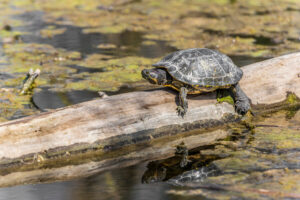
This small aquatic turtle is biologically known as Chrysemys picta marginata. They average a carapace’s length of between 4.5 and 5.5 inches and are domed. Their skin and shell are both colored, either black or brown.
Towards the edges, the shells are colored red or orange, while the skin has either red or yellow markings. Their head and neck have thin yellow stripes. A distinguishing characteristic of Midland turtles is the long claws on the forelimbs.
Being omnivores, the diet of midland turtles is majorly composed of fruits, seeds, and vegetation, mollusks, small aquatic animals, insects, and invertebrates. Midland painted turtle habitat consists of shallow, slow-moving water with soft bottoms for burrowing. These habitats include streams, ponds, lakes, and swamps with lots of dead vegetation and exposed for basking.
Midland-painted turtles are known to live for between 30 and 40 years.
The onset of sexual reproduction in males is about years, while it takes about eight years in females. Mating and nesting occur from April to September, when the hatchlings emerge from their shells. A female will lay about 4 to 10 eggs in a clutch.
Their eggs take approximately 60 to 90 days in incubation. They have little needs as pets, and even a beginner turtle owner can easily take care of them.
12. Mississippi Map Turtle
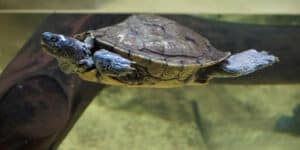
This turtle is another one of the map turtle subspecies. Their scientific name is Graptemys pseudogeographica kohnii.
They are mid-sized turtles, with females measuring between 6 and 10 inches while males measure 3.5 to 5 inches. Their carapace is rough and domed with a distinct vertebral keel. It is usually brown with dark lines, and the shells are serrated towards the edges.
Mississippi map turtles’ plastron has a light cream color. The skin is either olive or green with numerous long yellow stripes. A distinctive characteristic is their crescent-shaped thin yellow line behind each eye.
Mississippi map turtles are common in large streams and lakes, and being aquatic, they seldom leave the water unless when feeding and laying eggs. They are omnivores just like most map turtles and will feed on aquatic insects and their larvae, carrion, algae, aquatic vegetation, mollusks, and other small aquatic animals.
Mississippi map turtles have a lifespan of between 40 and 50 years.
Mating in Mississippi turtles happens from May; a female turtle will lay about 6-7 eggs in a clutch. Incubation lasts from 60 to 90 days. Sexual maturity takes about three years in males, while females take about five to seven years.
While they are not endangered, harvesting of female turtles, delayed maturity, and high juvenile mortality greatly impacts their numbers.
13. Midland Smooth Softshell Turtle
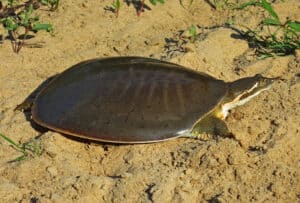
In scientific terms, known as Apalone mutica mutica, the Midland smooth softshell is one of the two smooth softshell turtle subspecies. What separates the two is their habitat in the wild.
Midland smooth softshell carapace has dark markings and skin covering their body instead of the scutes found in almost all the other turtles. This carapace has a brown or tan color in females. On the other hand, males’ carapace is either gray or brown.
The turtle’s feet, head, and tail have a pattern and color similar to that of the shell. Behind the eyes is a light stripe surrounded by black. Midland softshell also has a snout with circular nostrils but has no septal ridge.
This turtle subspecies grows medium to big as males measure 4.5″ – 11″ while females measure 6″ – 13″.
They live in a variety of still and flowing water bodies, preferably those with mud substrate or sand but without rocks. Their lifespan varies depending on diet and environmental facts, among other things, but they can live for 50 years on average.
Midland smooth softshell feeds on an omnivore diet with a higher preference for meat. Its most common meals include snails, fish, insects, vegetables, and fruits. They hide in a substrate and catch passing prey using their long necks. While males hunt in shallow water closer to the shores, females do so in deeper ones.
Nesting happens in sandy areas between May and July. They lay up to 3 clutches per year, carrying one to thirty-three eggs, with the number of eggs reducing with each subsequent clutch. The eggs take a minimum of 70, and a maximum of 100 does to hatch.
Midland smooth softshell are turtles of least concern in Kentucky.
14. Ouachita Map Turtle
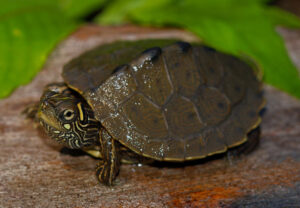
The scientific term for this turtle is Graptemys ouachitensis, but in some cases, it is regarded as a subspecies of False Map turtles and is also referred to as Graptemys pseudogeographica ouachitensis.
An Ouachita Map turtle has an oval carapace that is brown or olive. It features dark borders and has yellow markings, which are more visible when babies and fade away as they mature. The carapace’s back also has serrated edges, and its keel is low.
It is one of the turtles in Kentucky with a small head. Their skin is black or olive to brown with yellow lines in the neck, chin, tail, and limbs. They are omnivores, although they feed on more protein, especially males.
This Kentucky aquatic turtle is a good swimmer, and they are fond of big creeks or rivers with a moderate water current. Although they also inhabit sloughs and oxbow lakes, they hardly occupy small streams, lakes, and ponds. The presence of floating logs and hiding areas is vital in their habitat. These map turtles are pretty common in the eastern part of Kentucky.
Their males hardly grow big as they measure between 3.5″ and 5″ when mature. On the contrary, their females grow to almost double the size of the male Ouachita map turtles attaining a carapace length of 5″ to 10″. This size disparity is quite common with the other map turtles.
Mating takes place during spring and inside water. They lay up to 15 eggs and a minimum of 6 often in sandy areas. The eggs take between two and slightly below three months to hatch. Baby Ouachita map turtles emerge towards the end of summer, but they sometimes overwinter inside the nest.
Ouachita map turtles are species of least concern in Kentucky.
15. Southern Painted Turtle
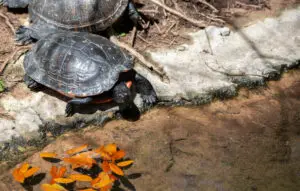
It is a subspecies of the painted turtles and goes by the name Chrysemys picta dorsalis in the scientific world.
A southern painted turtle is easily identifiable because of its solid yellow plastron. The carapace ranges from brown, black to olive, with yellow, red, or orange lines running from the front to back. Its skin is brown to black, and just like the shell, it has orange, red, or yellow lines.
These turtles are aquatic and fond of freshwaters, often found in slow-flowing rivers, lakes, and ponds. Southern painted turtles are widely distributed in Kentucky. They are omnivores meaning that they will feed on vegetables, fruits, plants, and aquatic invertebrates.
They have an average lifespan of 30 years.
Southern painted turtles lay eggs from March to June, often in the late afternoon and on sandy soils or ditches. Mating will have then taken place in shallow water. The clutches carry about four eggs which hatch after about 80 days.
Southern painted turtles are species of least concern in Kentucky.
16. Mississippi Mud Turtle

This turtle has a black or dark brown colored carapace. It bears the scientific term Kinosternon subrubrum hippocrepis. Its plastron is yellow with brown spots, while the skin is similar in color to the carapace, often black or dark brown. However, the skin has a pair of wide, irregular yellow lines running on each side of its neck and head.
They feed on an omnivorous diet, often eating snails, insects, fish, mussels, crayfish, vegetables, and a variety of vegetation.
Mississippi mud turtles are aquatic, with a great preference for waters with sandy or muddy bottoms. As such, these Kentucky native turtles live in swamps, oxbow lakes, and marshes. They avoid flowing waters. During winter, they hide in the mud at the base of the water bodies or hide in burrows far from the water.
When adults, Kentucky mud turtles measure 5” to 7”. Their lifespan ranges between 30 and 5 years.
Females get to sexual maturity at an average age of 7 years, or when they measure 3.5″ long. On the other hand, males mature at between 3″ and 3.75″ carapace length. They nest in May through to July. Females lay a maximum of 6 eggs in well-drained soils. Their incubation period is one of the longest among turtles as they take 100 – 110 days.
Mississippi mud turtles are species of least concern in Kentucky.
17. Red-eared Slider Turtle
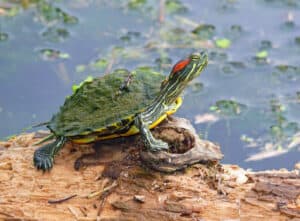
Lastly, we have one of the most popular aquatic pet turtle species because they are attractive, pretty easy to care for, and not delicate. Referred to as Trachemys scripta elegans, the red-eared slider is an invasive turtle species in most states, and it can survive in a variety of ecosystems.
Its most unique feature is the red streaks on its ears from which they get its name. In rare cases, the streaks can be orange or yellow. Their shells are dark olive and have yellow ribbons on the edges. Its skin is green to brown and also bears a ribbon pattern like that along its shell’s edges.
Red-eared sliders grow to a maximum carapace length of 12 inches, and females are, in most cases, bigger than sex. Their expected lifespan ranges between 20 and 50 years.
They feed on an omnivorous diet, often consisting of aquatic vegetation, fruits, snails, insects, and fish. In terms of habitat, these aquatic turtles live in slow-moving or still freshwaters. In Kentucky, they inhabit lakes, ponds, creeks, and streams.
Their females lay eggs between May and June, and these eggs take about 75 days in incubation. Baby turtles of red-eared sliders start fending for themselves and protecting themselves from predators right from hatching.
Red-eared sliders are turtle species of least concern in Kentucky.
Frequently Asked Questions
Now let’s answer some of your popular questions about Kentucky turtles.
Which Is the Most Popular Turtle Species in Kentucky?
The eastern box turtle is considered the most popular turtle in Kentucky. It is also one of the most common turtle species in Kentucky wildlife rehabilitation.
Is It Legal to Keep a Box Turtle in Kentucky?
Kentucky is home to only one box turtle; the Eastern box turtle. They are listed as threatened species owing to their declining populations. As such, it is illegal to sell box turtles in Kentucky. In addition, it is illegal to collect turtles from the wild in Kentucky.
Are There Alien Turtle Species in Kentucky?
The 11 turtle species we have discussed are native to Kentucky. However, there are a few other species found in this state, but they aren’t native and, as such, are referred to as alien. This often happens when turtles are released by their owners into the wild.
Conclusion
We have covered all the turtle species native to Kentucky, and it is evident that this state is rich in turtle diversity. While the turtles play a great role in the state’s food chain, some of them have been declining significantly in numbers.
Turtle species of great concern in Kentucky include the southern painted, Mississippi map, alligator snapping, and the false map turtle. It is illegal to collect turtles in the wild for domestication. You can, however, help a turtle cross the road in the direction it is moving to reduce the incidents of turtle’s road mortality.
We believe that you have learned more about these slow-moving creatures with a shell.
Learn more about other turtles species:
- Turtles In Oklahoma (17 Species Guide)
- Turtles In Maryland (Full Guide With Pictures)
- Turtles In Alabama (30 Species with Pictures)
- Indiana Native Turtles (Ultimate Guide With Pictures)
- Michigan Native Turtles (10 Species with Pictures)
- 18 Native Turtles in Tennessee (Guide With Pictures)
- Common Turtles Species in Massachusetts
- Turtles In South Carolina (20 Species With Pictures)
- Florida Turtles Guide (Full Guide With Pictures)